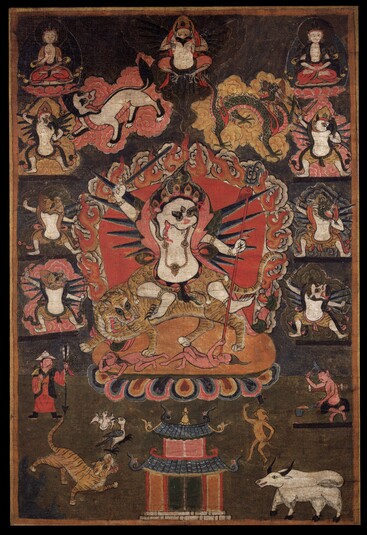
Item: Worldly Protector (Bon) - Werma Nyenya (Chang Sen)
| Origin Location | Naxi |
|---|---|
| Date Range | 1800 - 1899 |
| Material | Ground Mineral Pigment on Cotton |
| Collection | Shelley & Donald Rubin |
| Painting School | Provincial |
Classification: Deity
Werma Nyinya: a worldly deity arising from the Bon 'Treasure Tradition' and specifically the Chang Sen Tagdu text unearthed by Terton Ponse Khyung Gotsal (12th century).
Dynamic in appearance with one face and two hands, white in colour, he has the head of a lion - snarling and gaping. The right hand holds aloft a sword ready to strike and the left stretched to the side a trident on a long shaft. Wearing a flower and jewel crown the head is topped with a green bird. Adorned with a necklace, bracelets and anklets, a pink and green scarf is worn around the shoulders and the lower body is draped in a tiger skin skirt. Sharp blue wings extend from the back as he stands in a wrathful posture atop a raging tiger above two red figures, a sun disc and multi-coloured lotus seat. Six attendants in similar appearance stand at the right and left. (Textually there are 13 retinue figures).
At the top center is a garuda bird along with the four animals of the directions at the four corners; snow lion, dragon, tiger and white yak. At the top right and left are two seated figures, peaceful in appearance, each with one face and two hands, white in colour. At the lower left a standing man holds an arrow and on the right a blacksmith hammers over an anvil. A solitary bird clutches a bat with the beak and a monkey wields an axe.
In the Bon tradition there are four classes of worldly deities, all with a warrior-like appearance: (1) Dab La, (2) Chang Sen, (3) Welma and (4) Chug Gon. The central deity of this painting belongs to the Chang Sen classification.
Paintings of this subject are commonly found in the homes of lay practitioners and function as protective talismans against thieves, wild animals, war, pestilence, obstacles to wealth and for long-life. Artistic liberties are also found and less emphasis is placed on the strict textual description of the deity and surrounding retinue.
Jeff Watt & Lee Hartline 1-2000
(Please see The Arrow and the Spindle, Studies in History, Myths, Rituals and Beliefs in Tibet by Samten G Karmay. Manadala Book Point: 1998. Pages 256 & 257, The Ye and the Ngam).
Bon: Artworks (All)
Bon Religion: Protector Deities Main Page
Subject: Mountain Gods & Local Deities
Exhibition: Bon, The Magic Word (RMA 2007)
Subject: Winged Deities (Bon & Buddhist)
Region, China: Naxi Cultural Group
Bon Deity: Werma Nyinya Page
Collection of Shelley & Donald Rubin
Subject: Winged Deities List
Subject: Bird Imagery Main Page
Bon Deity: Deities with Wings
